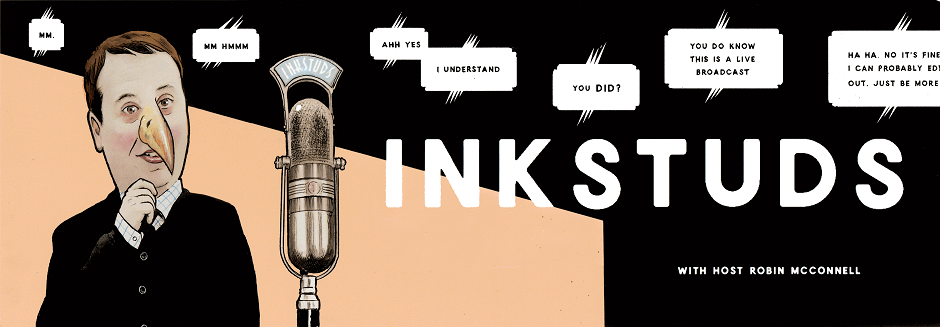Comics as we know it is wide and fractured. There’s Direct Market comics, bookstore comics, webcomics, indie comics, manga, Eurocomics, and several more subcultures. I’m curious about what working under the broad umbrella of “comics” is like for creators, publishers, critics, academics, and more. Over the course of this month, I’m going to interview several people whose work, position, or goals I find interesting and attempt to paint a picture of what “comics” means today.
For the month of February, I’m taking over the Inkstuds podcast in order to introduce Inkstuds Spotlight, a focused look at what it means to be in comics. A comprehensive look isn’t my goal. My goal is to show you several different slices of life in comics, as the people I’m interviewing this month play a wide variety of roles in comics.
A bit of context before we begin: Inkstuds is a comics podcast founded and hosted by Robin McConnell. It’s focused largely on indie and underground cartoonists, and now that it’s 500 episodes deep, exists as a great resource for finding out not just more about comics, but about the lives of cartoonists. ComicsAlliance is one of the most important news outlets in comics. I’m biased, having written for CA for a few years, but the staff has a voice and variety of interests that still can’t be matched. With both sites broadcasting Inkstuds Spotlight, I’m hoping we can reach a wide slice of the comics readership.
Today, I’m talking to LeSean Thomas. He works as a director, storyboard artist, character designer, and producer for the [adult swim] show Black Dynamite, a spin-off of the movie starring Michael Jai White. He also created the comic Cannon Busters and worked on cartoons like The Boondocks and Legend of Korra. Thomas may seem like an odd choice for a comics podcast at first blush, but his career trajectory offers a lot for aspiring creators to learn from, demonstrates the options available to artists today, and has a lot of practical knowledge to boot. Cartoons are comics-adjacent, especially in LeSean’s case, and I think the insights he has on becoming a working professional are valuable.
0:00: Thomas talks about what brought him to comics and art, growing up in the South Bronx, the natural creativity of children, remembering the people who encouraged his creativity, his first comic book convention in New York City, discovering and building a friend group who were aspiring artists around the time of the Image Revolution, comics seeming easier than animation as a teenager, meeting people who taught him about the science of art, getting a lucky break thanks to working at a sporting goods store, and putting a portfolio together for the first time.
10:00: Getting turned down and then getting another opportunity, working as an intern, the animated Disney film Hercules, doing forty drawings about Hercules in around three days, being into crosshatching and shadows, getting hired full-time, not going to art school, taking a class on animation, and segueing into animation production.
20:00: Preferring “self-disciplined” instead of “self-taught,” staying the course and learning from everyone, learning from any artist who’d be willing to teach him, getting frustrated at the compartmentalization of television production, quitting his job at Warner Bros. to move to South Korea to work, wanting to know more about animation production, passing on his knowledge through Seoul Sessions, doing a TEDx talk, the difficulty of living abroad, wanting to inspire up-and-coming kids, the importance of inspiring kids of color, shedding some light on how animation truly works, and the difficulty of staying visible when working in animation.
30:00: How knowing the bigger picture helps you as a creator, knowing the strengths of your team, why shows stand out and figuring out why they stand out, wanting to know everything, being mindful of the people you’re hiring and working with, using his time in Korea as an educational tool, the upsides of globalization, finding talent where the talent lives, what a producer actually does, and what “successful failure” means.
40:00: The honesty of children, the difference between not having a right answer as a kid and an adult, being afraid of failing, how many icons failed on their way to success, understanding the value of failing, leaving a legacy for younger artists, putting out the art book “The Foreign Exchange,” and his prior art books.
Recommended Links:
–Failing your way to success: LeSean Thomas at TEDxSinchon
–Black Dynamite
–The Boondocks
–The Legend of Korra
LeSean Thomas:
–LeSeanThomas.com
–Youtube (including Seoul Sessions)
–Tumblr
–DeviantArt
–Twitter
–IMDB


